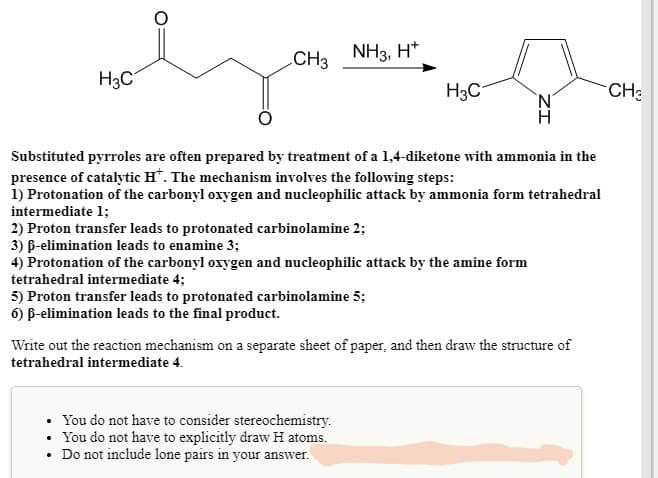CH3 NH3, H* H3C H3C CH `N' Substituted pyrroles are often prepared by treatment of a 1,4-diketone with ammonia in the presence of catalytic H*. The mechanism involves the following steps: 1) Protonation of the carbonyl oxygen and nucleophilic attack by ammonia form tetrahedral intermediate 1; 2) Proton transfer leads to protonated carbinolamine 2; 3) B-elimination leads to enamine 3; 4) Protonation of the carbonyl oxygen and nucleophilic attack by the amine form tetrahedral intermediate 4; 5) Proton transfer leads to protonated carbinolamine 5; 6) B-elimination leads to the final product. Write out the reaction mechanism on a separate sheet of paper, and then draw the structure of tetrahedral intermediate 4. You do not have to consider stereochemistry. • You do not have to explicitly draw H atoms. • Do not include lone pairs in your answer.
CH3 NH3, H* H3C H3C CH `N' Substituted pyrroles are often prepared by treatment of a 1,4-diketone with ammonia in the presence of catalytic H*. The mechanism involves the following steps: 1) Protonation of the carbonyl oxygen and nucleophilic attack by ammonia form tetrahedral intermediate 1; 2) Proton transfer leads to protonated carbinolamine 2; 3) B-elimination leads to enamine 3; 4) Protonation of the carbonyl oxygen and nucleophilic attack by the amine form tetrahedral intermediate 4; 5) Proton transfer leads to protonated carbinolamine 5; 6) B-elimination leads to the final product. Write out the reaction mechanism on a separate sheet of paper, and then draw the structure of tetrahedral intermediate 4. You do not have to consider stereochemistry. • You do not have to explicitly draw H atoms. • Do not include lone pairs in your answer.
Organic Chemistry
8th Edition
ISBN:9781305580350
Author:William H. Brown, Brent L. Iverson, Eric Anslyn, Christopher S. Foote
Publisher:William H. Brown, Brent L. Iverson, Eric Anslyn, Christopher S. Foote
Chapter18: Functional Derivatives Of Carboxylic Acids
Section: Chapter Questions
Problem 18.38P: A step in a synthesis of PGE1 (prostaglandin E1, alprostadil) is the reaction of a trisubstituted...
Related questions
Question

Transcribed Image Text:CH3
NH3, H*
H3C
H3C
CH:
Substituted pyrroles are often prepared by treatment of a 1,4-diketone with ammonia in the
presence of catalytic H*. The mechanism involves the following steps:
1) Protonation of the carbonyl oxygen and nucleophilic attack by ammonia form tetrahedral
intermediate 1;
2) Proton transfer leads to protonated carbinolamine 2;
3) B-elimination leads to enamine 3;
4) Protonation of the carbonyl oxygen and nucleophilic attack by the amine form
tetrahedral intermediate 4;
5) Proton transfer leads to protonated carbinolamine 5;
6) B-elimination leads to the final product.
Write out the reaction mechanism on a separate sheet of paper, and then draw the structure of
tetrahedral intermediate 4.
• You do not have to consider stereochemistry.
You do not have to explicitly draw H atoms.
Do not include lone pairs in your answer.
ZI
Expert Solution
This question has been solved!
Explore an expertly crafted, step-by-step solution for a thorough understanding of key concepts.
This is a popular solution!
Trending now
This is a popular solution!
Step by step
Solved in 2 steps with 2 images

Knowledge Booster
Learn more about
Need a deep-dive on the concept behind this application? Look no further. Learn more about this topic, chemistry and related others by exploring similar questions and additional content below.Recommended textbooks for you

Organic Chemistry
Chemistry
ISBN:
9781305580350
Author:
William H. Brown, Brent L. Iverson, Eric Anslyn, Christopher S. Foote
Publisher:
Cengage Learning

Organic Chemistry
Chemistry
ISBN:
9781305580350
Author:
William H. Brown, Brent L. Iverson, Eric Anslyn, Christopher S. Foote
Publisher:
Cengage Learning